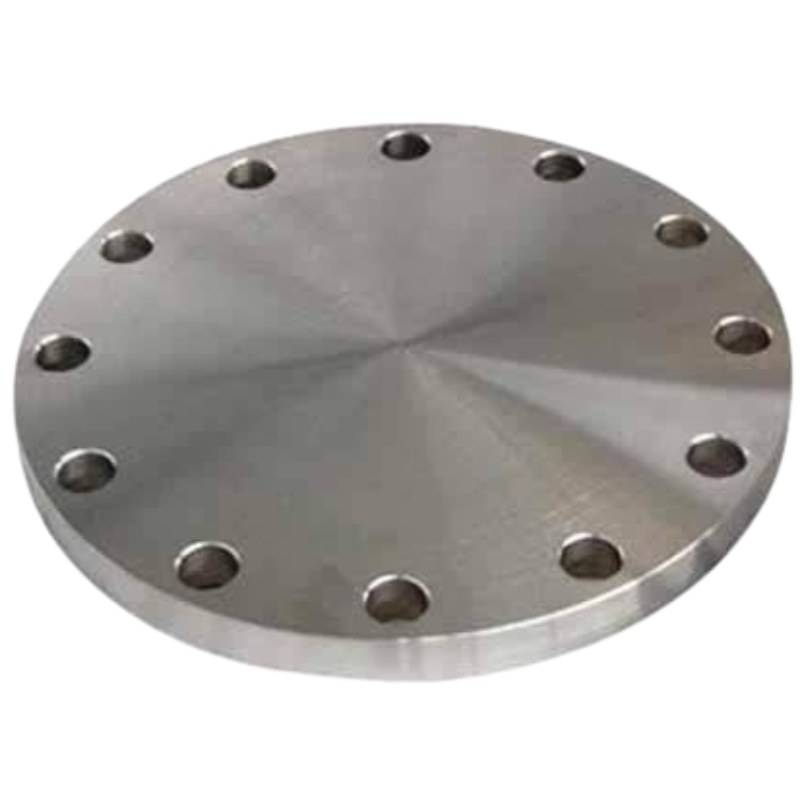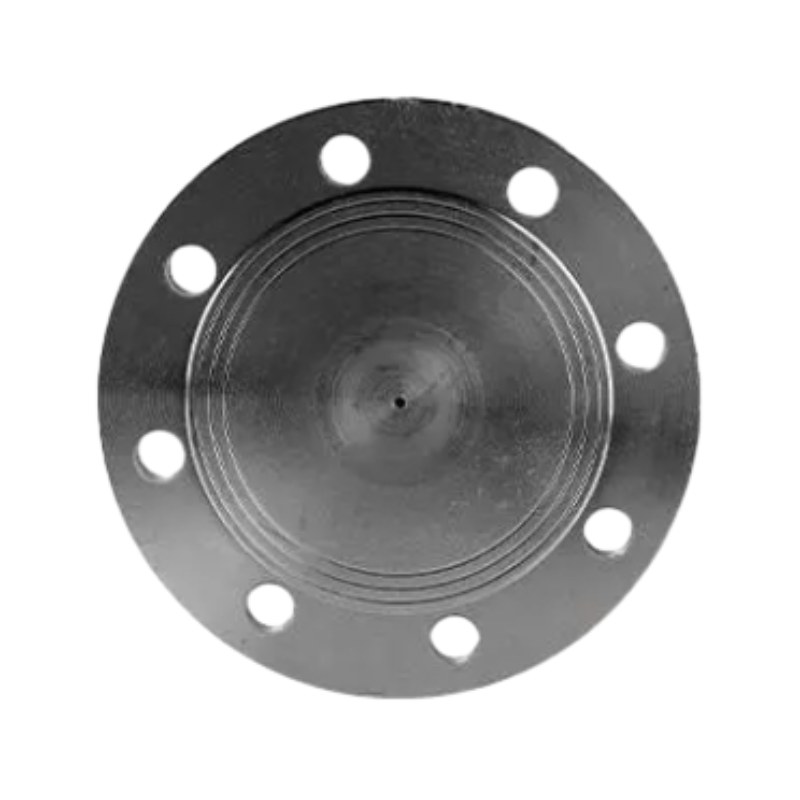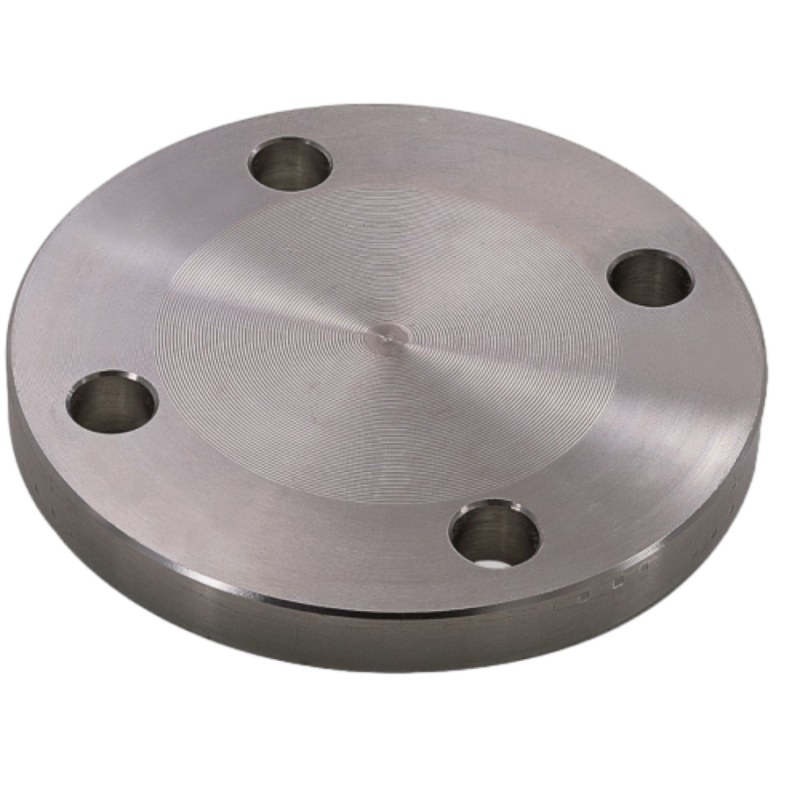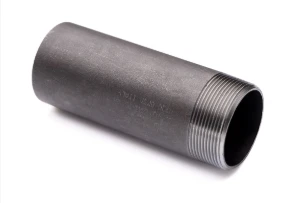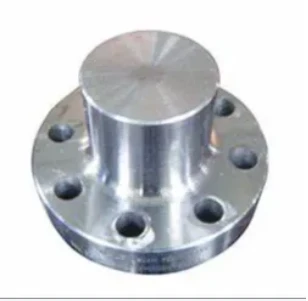-
DIN2527 Standard nga Pagsunod:
Ang DIN2527 nga mga blind flanges nagsunod sa mga detalye nga gilatid sa Deutsches Institut für Normung (DIN), nga nagsiguro sa pagkaparehas ug pagkaangay sa ubang mga sangkap nga nagsunod sa DIN. Gipasimple sa kini nga standardisasyon ang paghiusa sa mga buta nga flanges sa mga sistema sa tubo, nga nagpasiugda sa hapsay nga operasyon ug pagpadayon. - Silyado nga Pagsira:
Ang mga buta nga flanges nagsilbi nga hinungdanon nga gimbuhaton sa pagbugkos sa mga tumoy sa tubo o mga pag-abli sa usa ka sistema sa tubo. Ang DIN2527 nga mga blind flanges adunay usa ka solid, patag nga disc nga adunay mga bolt hole sa palibot sa perimeter, nga nagtugot kanila nga ma-bolted nga luwas sa mating flange o pipe end. Kini nga silyado nga pagsira nagpugong sa pagtulo sa mga likido o gas, pagmintinar sa integridad ug kaluwasan sa sistema sa tubo. -
Daghag Gamit nga Aplikasyon:
Ang DIN2527 nga mga blind flanges nakit-an ang aplikasyon sa lainlaing mga industriya, lakip ang lana ug gas, pagproseso sa kemikal, pagtambal sa tubig, paghimo sa kuryente, ug paghimo sa barko. Gigamit kini sa mga pipeline, pressure vessel, ug mga tangke sa pagtipig aron babagan ang wala magamit o temporaryo nga mga pag-abli, ihimulag ang mga seksyon sa piping alang sa pagpadayon o pag-ayo, o ingon usa ka paagi sa pag-inspeksyon ug pagsulay. -
Pagpili sa Materyal:
Ang mga buta nga flanges anaa sa lain-laing mga materyales nga mohaum sa lain-laing mga operating kondisyon ug media. Ang kasagarang mga materyales naglakip sa carbon steel, stainless steel, alloy steel, ug non-ferrous alloys sama sa brass o bronze. Ang pagpili sa materyal nagdepende sa mga hinungdan sama sa temperatura, presyur, resistensya sa kaagnasan, ug pagkaangay sa likido o gas nga gidumala. -
Mga Rating sa Presyon:
Ang DIN2527 blind flanges gidisenyo aron makasugakod sa piho nga mga rating sa presyur, gikan sa PN6 ngadto sa PN100, sumala sa mga sumbanan sa DIN. Ang rating sa presyur nagdiktar sa labing taas nga gitugot nga presyur nga luwas nga maagwanta sa flange nga dili ikompromiso ang integridad sa istruktura o pasundayag sa pagbugkos. Mahinungdanon ang pagpili sa mga blind flanges nga adunay tukma nga rating sa presyur alang sa gituyo nga aplikasyon aron masiguro ang luwas ug kasaligan nga operasyon. -
Mga Opsyon sa Pag-customize:
While DIN2527 blind flanges conform to standard dimensions and specifications, customization options are available to accommodate unique project requirements. This may include variations in flange size, facing type (such as flat face or raised face), bolt-hole pattern, and special coatings or treatments for enhanced corrosion resistance. Customized blind flanges are often tailored to fit specific piping configurations and operating conditions.
What Is a Blind Flange?
A blind flange is a solid, circular plate used to seal off the ends of piping systems, valves, or pressure vessels. Unlike other different flange types, blind flanges lack a central bore, making them ideal for completely closing off a pipeline or opening. They are commonly utilized in various industrial applications, including oil and gas, chemical processing, water treatment, and power generation, where secure and leak-proof pipe closures are essential.
Blind flanges are available in a wide range of sizes and pressure ratings, conforming to industry standards such as ANSI, ASME, and DIN. Sizes range from small diameters, like a 2-inch blind flange, to larger options, such as 36 blind flanges, catering to diverse operational requirements. The design typically features bolt holes around the perimeter, allowing the flange to be securely fastened to a mating component, like a pipe flange or valve.
The primary purpose of a blind flange is to isolate sections of a pipeline for maintenance, testing, or system modifications without disrupting the entire operation. They also play a critical role in pressure testing, allowing operators to evaluate the system's capacity under specific conditions.
Materials for blind flanges include stainless steel, carbon steel, alloy steel, and other metals, ensuring compatibility with various operating environments, including high-temperature, high-pressure, or corrosive conditions. Some blind flanges also feature coatings or linings for additional durability.
Blind flanges are essential for ensuring safety, system integrity, and operational flexibility. Their robust design and adaptability make them indispensable in industrial piping systems, providing reliable sealing solutions and enhancing overall efficiency.
What Is a Blind Flange Used For
Pipeline Isolation
Blind flanges are commonly used to isolate sections of a pipeline for maintenance, repairs, or system upgrades. By sealing off the pipeline, operators can work on specific sections without interrupting the entire operation.
System Testing
In pressure testing scenarios, blind flanges enable operators to assess the strength and performance of the pipeline or vessel under controlled conditions. The flange helps maintain pressure within the system during testing, ensuring accurate results.
Future Expansion
Blind flanges can be installed at pipeline terminations where future expansions are anticipated. They temporarily seal the system, allowing additional components to be integrated later without significant modifications.
Safety in Shutdowns
During system shutdowns, blind flanges ensure that no residual fluids or gases escape, enhancing safety for maintenance crews and protecting the environment.
Preventing Contamination
In industries like food processing or pharmaceuticals, blind flanges are used to prevent contamination by securely sealing unused pipeline sections.
Blind Flange Types
Standard Blind Flanges
Standard blind flanges are flat, solid discs with no central bore. They are designed to fit a variety of piping systems and are often categorized by standards such as ANSI, ASME, and DIN. These flanges are versatile and used in applications with moderate pressure and temperature conditions.
Raised Face (RF) Blind Flanges
Raised face blind flanges feature a slightly elevated sealing surface. The raised face provides a better seal when paired with gaskets, making them suitable for higher-pressure applications in industries like oil and gas.
Flat Face (FF) Blind Flanges
Flat-face blind flanges have a uniform sealing surface that lies flush with the pipe flange. They are ideal for systems where flange surfaces must be evenly distributed to prevent damage, such as in low-pressure environments.
Ring-Type Joint (RTJ) Blind Flanges
RTJ blind flanges feature a grooved surface to accommodate metal gaskets. This design provides superior sealing, making them ideal for high-pressure and high-temperature systems, such as petrochemical plants.
Threaded Blind Flanges
Threaded blind flanges have threads on their inner surface, allowing them to be screwed directly onto a threaded pipe. They are commonly used in low-pressure systems and applications requiring quick assembly and disassembly.
DIN 2527 Blind Flange Advantages
The DIN 2527 blind flange is an essential component in piping systems, particularly in industrial applications where robust sealing is required. This type of flange offers several advantages, making it a preferred choice for many engineers and designers.
Firstly, one of the main benefits of the DIN 2527 blind flange is its ability to provide a secure and leak-proof seal. By covering the ends of pipes, it effectively blocks the flow, preventing any unwanted leaks or exposures. This is particularly critical in systems that transport hazardous materials, where safety and environmental protection are of utmost importance.
Secondly, the DIN 2527 blind flange is designed to withstand high pressure and temperature conditions, which ensures durability and long service life. Constructed from various materials, including stainless steel, carbon steel, and alloys, these flanges can be tailored to meet specific operational requirements, enhancing their reliability under extreme conditions.
Another advantage is the easy installation process. The blind flange can be easily bolted to the end of a pipe without requiring any special tools or complex techniques. This simplifies the assembly process and allows for quicker maintenance or modifications in the future.
Additionally, blind flanges are highly versatile and can be used in a range of applications, from oil and gas to water treatment and chemical processing. This versatility makes the DIN 2527 blind flange an excellent solution for diverse industries.
Moreover, using blind flanges can enhance the system's overall design by facilitating future expansions or modifications. Since they can be removed and replaced without extensive alterations to the piping layout, they provide flexibility in system management.
In summary, the DIN 2527 blind flange offers secure sealing, durability, ease of installation, versatility, and design flexibility, making it a vital component in many industrial piping systems. Its advantages contribute significantly to operational efficiency and safety, solidifying its status as a preferred choice in various applications.
Ang DIN2527 nga mga buta nga flanges mga kinahanglanon nga sangkap sa mga sistema sa tubo, nga naghatag usa ka kasaligan ug dili masaligan nga pagsira sa mga tumoy sa tubo o mga pag-abli. Ang ilang pagsunod sa DIN standards, versatility, ug customizable nga mga opsyon naghimo kanila nga angayan alang sa usa ka halapad nga industriyal nga mga aplikasyon diin ang hugot nga pagbugkos ug pressure containment kritikal. Uban sa DIN2527 blind flanges, ang mga inhenyero ug mga operator makasiguro sa integridad, kaluwasan, ug kaepektibo sa ilang mga sistema sa tubo, nga makatampo sa hapsay ug walay problema nga mga operasyon sa tibuok industriya.








